Collaborative Approaches for Cyber Security in Cyber-Physical Systems, no. Part of the Advanced Sciences and Technologies for Security Applications book series (ASTSA), Springer, pp. 145-170, 01/2023. DOI

Advances in Core Computer Science-Based Technologies, Springer International Publishing, pp. 157-173, 2021. DOI
Abstract
Internet of Things (IoT) technologies have enabled Cyber-Physical Systems (CPS) to become fully interconnected. This connectivity however has radically changed their threat landscape. Existing risk assessment methodologies often fail to identify various attack paths that stem from the new connectivity/functionality features of IoT-enabled CPS. Even worse, due to their inherent characteristics, IoT systems are usually the weakest link in the security chain and thus many attacks utilize IoT technologies as their key enabler. In this paper we review risk assessment methodologies for IoT-enabled CPS. In addition, based on our previous work (Stellios et al. in IEEE Commun Surv Tutor 20:3453–3495, 2018, [47]) on modeling IoT-enabled cyberattacks, we present a high-level risk assessment approach, specifically suited for IoT-enabled CPS. The mail goal is to enable an assessor to identify and assess non-obvious(indirect or subliminal) attack paths introduced by IoT technologies, that usually target mission critical components of an CPS.
Encyclopedia of Cryptography, Security and Privacy, Springer Berlin Heidelberg, pp. 1--3, 08/2021. DOI
Security and Privacy for Big Data, Cloud Computing and Applications, Lizhe Wang, Wei Ren, Raymoond Choo and Fatos Xhafa, The Institution of Engineering and Technology (IET) , 09/2019.
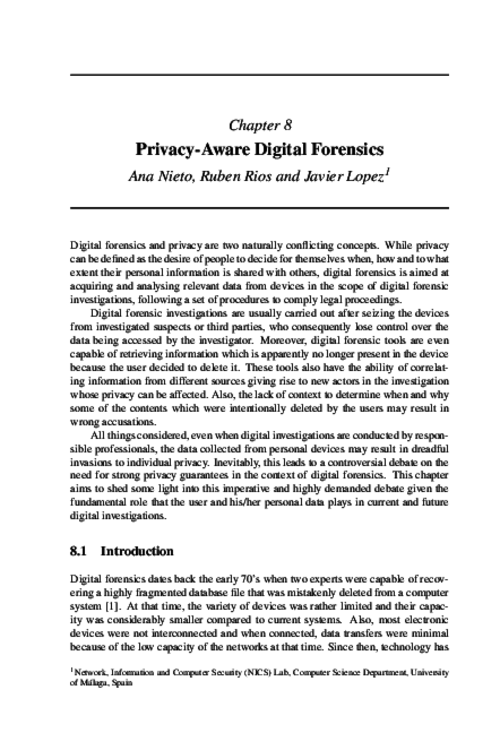
Critical Infrastructure Security and Resilience: Theories, Methods, Tools and Technologies, no. Advanced Sciences and Technologies for Security Applications book series (ASTSA), Springer International Publishing, pp. 201-217, 01/2019. DOI
Abstract
Increasingly, the society is witnessing how today’s industry is adapting the new technologies and communication protocols to offer more optimal and reliable services to end-users, with support for inter-domain communication belonging to diverse critical infrastructures. As a consequence of this technological revolution, interconnection mechanisms are required to offer transparency in the connections and protection in the different application domains, without this implying a significant degradation of the control requirements. Therefore, this book chapter presents a reference architecture for the new Industry 4.0 where the interconnection core is mainly concentrated in the Policy Decision Points (PDP), which can be deployed in high volume data processing and storage technologies such as cloud and fog servers. Each PDP authorizes actions in the field/plant according to a set of factors (entities, context and risks) computed through the existing access control measures, such as RBAC+ABAC+Risk-BAC (Role/Attribute/Risk-Based Access Control, respectively), to establish coordinated and constrained accesses in extreme situations. Part of these actions also includes proactive risk assessment measures to respond to anomalies or intrusive threats in time.
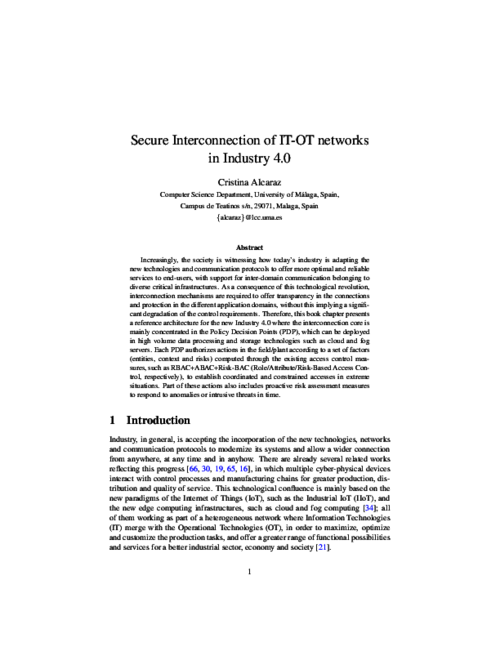
Cyber-Physical Systems: Foundations, Principles and Applications, no. Intelligent Data-Centric Systems, Academic Press, pp. 305 - 317, 2017. DOI
Abstract
Abstract Cyber-physical systems (CPSs), integrated in critical infrastructures, could provide the minimal services that traditional situational awareness (SA) systems demand. However, their application in SA solutions for the protection of large control distributions against unforeseen faults may be insufficient. Dynamic protection measures have to be provided not only to locally detect unplanned deviations but also to prevent, respond, and restore from these deviations. The provision of these services as an integral part of the SA brings about a new research field known as wide-area situational awareness (WASA), highly dependent on CPSs for control from anywhere across multiple interconnections, and at any time. Thus, we review the state-of-the art of this new paradigm, exploring the different preventive and corrective measures considering the heterogeneity of CPSs, resulting in a guideline for the construction of automated WASA systems.
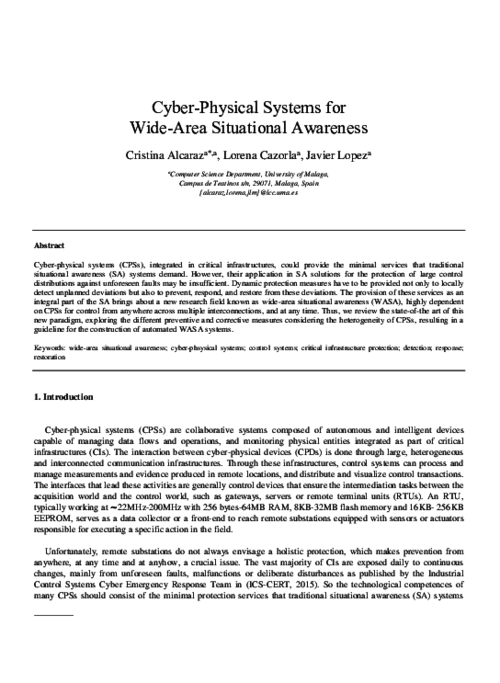
Security Solutions and Applied Cryptography in Smart Grid Communications, IGI Global, USA, IGI Global, pp. 137-158, 2017. DOI
Abstract
Transparency in control transactions under a secure network architecture is a key topic that must be discussed when aspects related to interconnection between heterogeneous cyber-physical systems (CPSs) arise. The interconnection of these systems can be addressed through an enforcement policy system responsible for managing access control according to the contextual conditions. However, this architecture is not always adequate to ensure a rapid interoperability in extreme crisis situations, and can require an interconnection strategy that permits the timely authorized access from anywhere at any time. To do this, a set of interconnection strategies through the Internet must be studied to explore the ability of control entities to connect to the remote CPSs and expedite their operations, taking into account the context conditions. This research constitutes the contribution of this chapter, where a set of control requirements and interoperability properties are identified to discern the most suitable interconnection strategies.
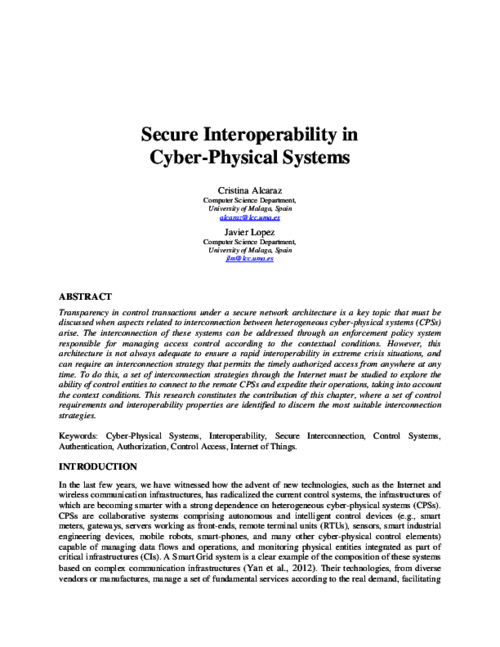
Accountability and Security in the Cloud, vol. 8937, no. LNCS Tutorial, pp. 129-153, 2015.
Accountability and Security in the Cloud, M. Felici, and C. Fernandez-Gago Eds., Lecture Notes in Computer Science 8937, Springer International Publishing, pp. 114-125, 2015. DOI
Abstract
In this paper we tackle the problem of privacy and confidentiality in Identity Management as a Service (IDaaS). The adoption of cloud computing technologies by organizations has fostered the externalization of the identity management processes, shaping the concept of Identity Management as a Service. However, as it has happened to other cloud-based services, the cloud poses serious risks to the users, since they lose the control over their data. As part of this work, we analyze these concerns and present a model for privacy-preserving IDaaS, called BlindIdM, which is designed to provide data privacy protection through the use of cryptographic safeguards.
Engineering Secure Future Internet Services and Systems, vol. LNCS 8431, no. 8431, Springer, pp. 180-209, 03/2014. DOI
Abstract
The Future Internet (FI) comprises scenarios where many heterogeneous and dynamic entities must interact to provide services (e.g., sensors, mobile devices and information systems in smart city scenarios). The dynamic conditions under which FI applications must execute call for self-adaptive software to cope with unforeseeable changes in the application environment. Models@run.time is a promising model-driven approach that supports the runtime adaptation of distributed, heterogeneous systems. Yet frameworks that accommodate this paradigm have limited support to address security concerns, hindering their usage in real scenarios. We address this challenge by enhancing models@run.time with the concepts of trust and reputation. Trust improves decision-making processes under risk and uncertainty and constitutes a distributed and flexible mechanism that does not entail heavyweight administration. This chapter introduces a trust and reputation framework that is integrated into a distributed component model that implements the models@run.time paradigm, thus allowing software components to include trust in their reasoning process. The framework is illustrated in a smart grid scenario.
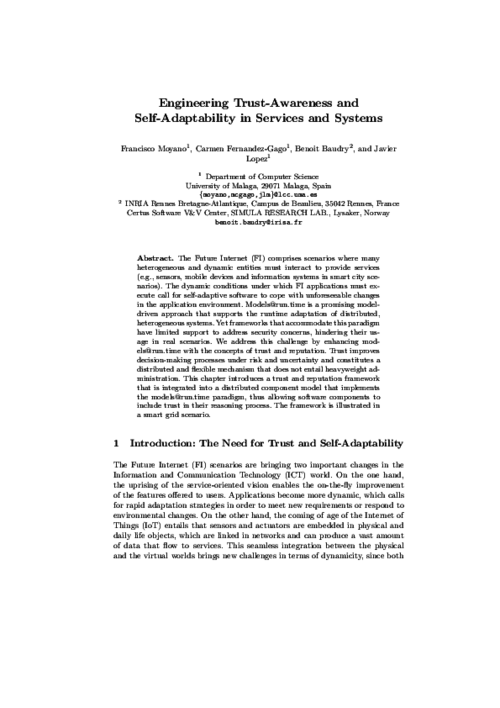
Foundations of Security Analysis and Design VII, vol. 8604, no. LNCS, Springer, pp. 244-282, 2014. DOI
Abstract
Privacy preservation is gaining popularity in Wireless Sensor Network (WSNs) due to its adoption in everyday scenarios. There are a number of research papers in this area many of which concentrate on the location privacy problem. In this paper we review and categorise these solutions based on the information available to the adversary and his capabilities. But first we analyse whether traditional anonymous communication systems conform to the original requirements of location privacy in sensor networks. Finally, we present and discuss a number of challenges and future trends that demand further attention from the research community.
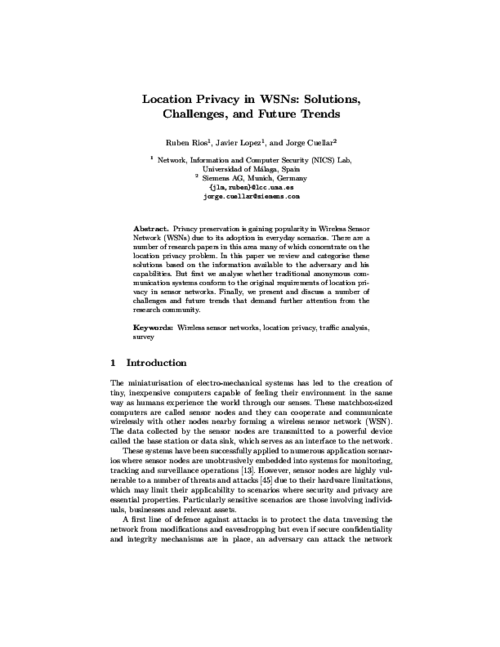
Critical Infrastructure Protection: Information Infrastructure Models, Analysis, and Defense, J. Lopez, S.. Wolthunsen, and R. Setola Eds., Advances in Critical Infrastructure Protection: Information Infrastructure Models, Analysis, and Defense. LNCS 7130. 7130, Springer-Verlag, pp. 120-149, September 2012.
Abstract
SCADA Systems can be seen as a fundamental component in Critical Infrastructures, having an impact in the overall performance of other Critical Infrastructures interconnected. Currently, these systems include in their network designs different types of Information and Communication Technology systems (such as the Internet and wireless technologies), not only to modernize operational processes but also to ensure automation and real-time control. Nonetheless, the use of these new technologies will bring new security challenges, which will have a significant impact on both the business process and home users. Therefore, the main purpose of this Chapter is to address these issues and to analyze the interdependencies of Process Control Systems with ICT systems, to discuss some security aspects and to offer some possible solutions and recommendations.
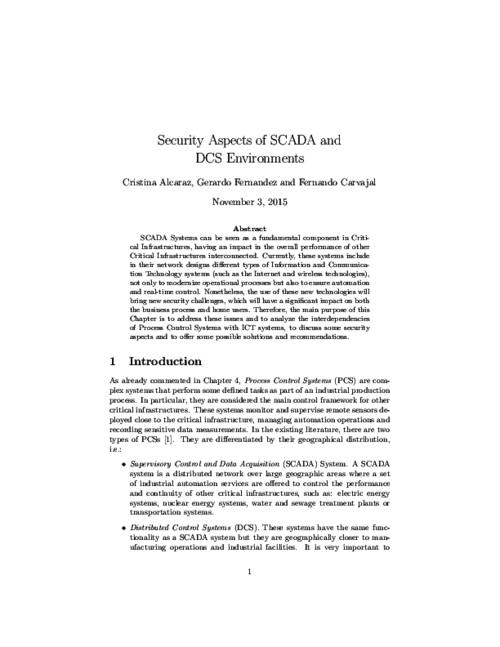
Digital Home Networking, R. Carbou, E. Exposito, R. Roman, and M. Diaz Eds., no. 7130, John Wiley & Sons Inc., pp. 60-96, 2011.
Digital Home Networking, R. Carbou, E. Exposito, and R. Roman Eds., Wiley-ISTE, pp. 17 - 58, 2011.
Digital Home Networking, R. Carbou, M. Diaz, E. Exposito, and R. Roman Eds., pp. 139-202, 2011.
Advances in Grid Computing, Zoran Constantinescu, Intech, pp. 173-198, 2011.

Security and Privacy in Mobile and Wireless Networking, S. Gritzalis, T. Karygiannis, and C. Skianis Eds., Troubador Publishing Ltd, pp. 105-128, 2009.
Abstract
The concept of trust has become very relevant in the late years as a consequence of the growth of fields such as internet transactions or electronic commerce. In general, trust has become of paramount importance for any kind of distributed networks, such as wireless sensor networks (WSN in the following). In this chapter of the book, we try to give a general overview of the state of the art on trust management systems for WSN and also try to identify the main features of the architectures of these trust management systems.
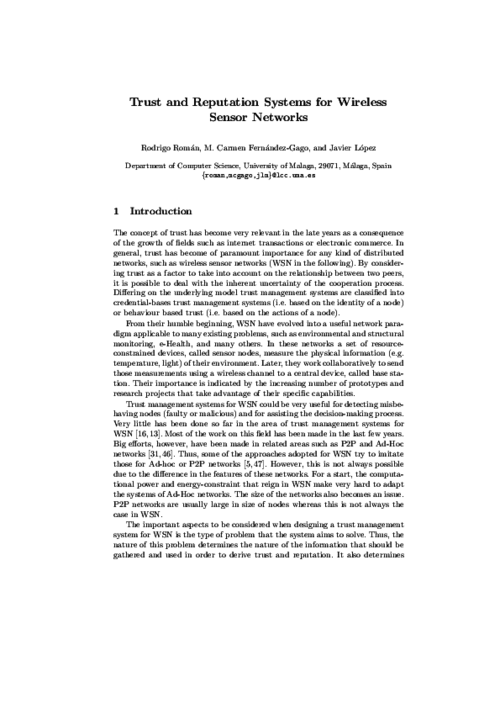
Wireless Sensor Network Security, J. Lopez, and J. Zhou Eds., IOS Press, 2008.
Abstract
Security has been proven a crucial factor in the provision of data services and especially in the computer-related environments. While wired and wireless networks come to all sectors of everyday life, security tries to satisfy the growing needs for confidentiality, integrity and non-repudiation. There are many instances of security primitives and each one of them has different requirements in terms of processing power, word size, etc. Therefore, it is important to review the functionality of the less resource-demanding encryption algorithms in order to analyze their theoretical suitability to the existent sensor node hardware. Still, the constraints inherent to the sensor nodes advise against the total dependence on software-based implementations, even more in the case of expensive primitives.
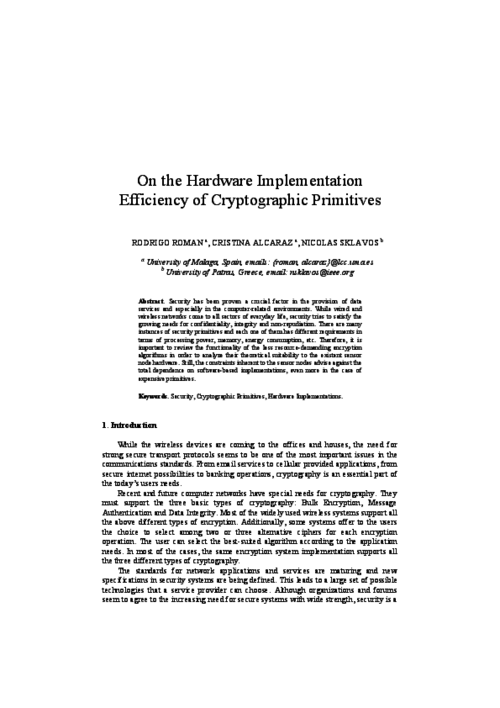
Security in Distributed, Grid, Mobile, and Pervasive Computing, Y.. Xiao Eds., Auerbach Publications, pp. 255-288, April, 2007.

On Foundations of Security Analysis and Design IV, FOSAD 2006/2007, Springer, LNCS 4677, pp. 160-182, 2007. DOI
Abstract
Critical Infrastructures are complex and highly interconnected systems that are crucial for the well-being of the society. Any type of failure can cause significant damage, affecting one or more sectors due to their inherent interdependency. Not only the infrastructures are critical, but also the information infrastructures that manage, control and supervise them. Due to the seriousness of the consequences, the protection of these critical (information) infrastructures must have the highest priority. It is the purpose of this book chapter to review and discuss about these infrastructures, to explain their elements, and to highlight their research and development issues. This chapter will also discuss the role of Wireless Sensor Network (WSN) technology in the protection of these infrastructures.

Digital Privacy: Theory, Technologies, and Practices, A.. Acquisti, S. Gritzalis, C.. Lambrinoudakis, and S. De Capitan di Vimercati Eds., Auerbach Publications, pp. 285-306, December, 2007.
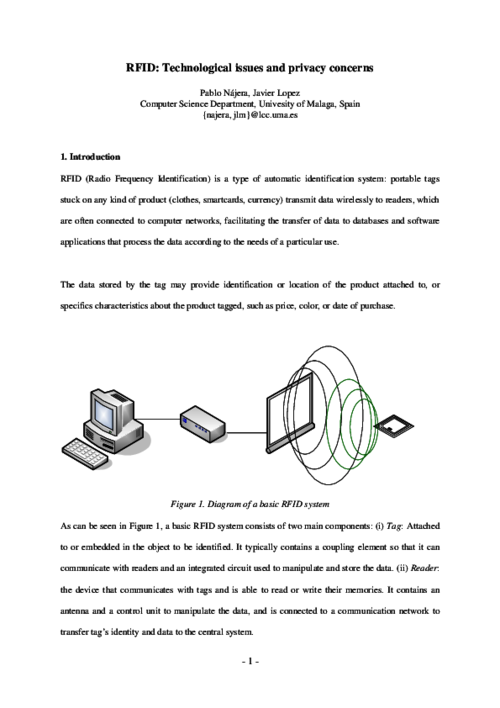
 ]
]